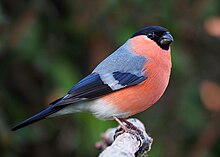Pyrrhula
| Bullfinches | |
|---|---|

| |
| Eurasian bullfinch, Pyrrhula pyrrhula | |
| Scientific classification | |
| Domain: | Eukaryota |
| Kingdom: | Animalia |
| Phylum: | Chordata |
| Class: | Aves |
| Order: | Passeriformes |
| Family: | Fringillidae |
| Subfamily: | Carduelinae |
| Genus: | Pyrrhula Brisson, 1760 |
| Species | |
|
See text. | |
Pyrrhula is a small genus of passerine birds, commonly called bullfinches, belonging to the finch family (Fringillidae).
The genus has a palearctic distribution. All species occur in Asia with two species exclusively in the Himalayas and one species, P. pyrrhula, also occurring in Europe. The Azores bullfinch (P. murina) is a critically endangered species (about 120 pairs remaining), occurring only in the east of the island of São Miguel in the Azores archipelago.
Analysis of the mtDNA cytochrome b sequence indicates that the holarctic pine grosbeak (Pinicola enucleator) is the closest living relative of this genus. Arguably, it could be included in Pyrrhula, but more probably is a distinct offshoot of a common ancestor, with the pine grosbeak as the sister group to the ancestor of the bullfinches.[1] The evolution of the bullfinch species started soon after the pine grosbeak's ancestors diverged from them (at the end of the Middle Miocene, about a dozen mya), and it is quite possible that the latter species evolved in North America; what is fairly certain is that the bullfinch radiation started in the general area of the Himalayas. The mountain finches also seem to be part of this clade.[2]
Bullfinches have glossy black wings and tail feathers. They show a white rump. The legs and feet are fleshy brown. Their short, swollen bill is adapted to eat buds, and is black except for the brown bullfinch, which has a grey or greenish-grey bill. The males can be distinguished by their orange or red breast. Some species have a black cap.
The name of Pyrrhula for the genus was introduced by the French zoologist Mathurin Jacques Brisson in 1760.[3][4] It was derived by tautonymy from the binomial name of the Eurasian bullfinch Loxia pyrrhula introduced by Linnaeus in 1758.[4][5]
Species

There are eight recognised species in the genus:[6]
- Orange bullfinch, Pyrrhula aurantiaca
- Grey-headed bullfinch, Pyrrhula erythaca
- Red-headed bullfinch, Pyrrhula erythrocephala
- White-cheeked bullfinch, Pyrrhula leucogenis
- Azores bullfinch, Pyrrhula murina
- Brown bullfinch, Pyrrhula nipalensis
- Eurasian bullfinch, Pyrrhula pyrrhula
- Pyrrhula crassa extinct [7]
References
- ^ Arnaiz-Villena, A; et al. (2001). "Phylogeography of crossbills, bullfinches, grosbeaks, and rosefinches". Cellular and Molecular Life Sciences. 58 (8): 1159–1166. doi:10.1007/pl00000930. PMID 11529508.
- ^ Marten, Jill A.; Johnson, Ned K. (1986). "Genetic relationships of North American cardueline finches" (PDF). Condor. 88 (4): 409–420. doi:10.2307/1368266.
{{cite journal}}: Unknown parameter|lastauthoramp=ignored (|name-list-style=suggested) (help) - ^ Brissons, M.J. (1760). Ornithologie, Volume 1. Paris: Chez C.J.-B. Bauche. p. 36.
- ^ a b Paynter, Raymond A. Jnr., ed. (1968). Check-list of birds of the world, Volume 14. Cambridge, Massachusetts: Museum of Comparative Zoology. p. 293.
- ^ Linnaeus, C. (1758). Systema Naturæ per regna tria naturae, secundum classes, ordines, genera, species, cum characteribus, differentiis, synonymis, locis, Volume 1 (in Latin) (10th ed.). Holmiae:Laurentii Salvii. pp. 171–172.
- ^ Gill, Frank; Donsker, David (eds.). "Finches, euphonias". World Bird List Version 5.2. International Ornithologists' Union. Retrieved 5 June 2015.
- ^ Rando, J.C; Pieper, H; Olson, Olson Storrs; Pereira, F; Alcover, J.A. "A new extinct species of large bullfinch (Aves: Fringillidae: Pyrrhula) from Graciosa Island (Azores, North Atlantic Ocean)" (PDF). Zootaxa. 4282: 567–583. Retrieved 6 August 2017.
